Hello Nature readers, would you like to get this Briefing in your inbox free every day? Sign up here.
The cloned rhesus monkey, named ReTro, is the first to survive to adulthood.Credit: Qiang Sun
Cloned rhesus monkey lives into adulthood
For the first time, a rhesus monkey cloned in the laboratory has lived into adulthood — surviving for more than two years so far. The feat was achieved using a slightly different approach to the conventional cloning technique used to clone Dolly the sheep and other mammals, including long-tailed macaques, the first primates to ever be cloned. The new technique could unlock possibilities for using cloned primates in drug testing and behavioural research. “We could produce a large number of genetically uniform monkeys that can be used for drug-efficacy tests,” says neuroscientist Mu-ming Poo.
Nature | 5 min read
Reference: Nature Communications paper
Largest genetic atlas of marine microbes
A trove of around 315 million gene groups from ocean bacteria, fungi and viruses has been made freely available online. The database includes more genomic data from the deep sea and sea floor than previous catalogues. More than half of the gene groups from the ‘twilight zone’, at depths of 200 to 1,000 metres, came from fungi, which suggests that they play a greater part in processing organic matter than previously thought. The database could help researchers to discover new antibiotics, or to monitor the impacts of burning fossil fuels or deep-sea mining on microbial diversity.
Nature | 4 min read
Reference: Frontiers in Science paper
Underwater curtains to slow glacier melting
Glaciologists have proposed a drastic idea to slow the melting of polar ice: erecting giant underwater ‘curtains’ near glaciers to protect them from warm ocean water. Critics say that the proposal would be expensive and difficult to construct, and might interfere with local ecosystems or distract us from the essential work of slashing greenhouse-gas emissions. The concept builds on a 2018 proposal in which glaciologist John Moore and three colleagues made a heartfelt plea to consider such bold ideas, given the toll that rising sea levels will take on humanity. “We understand the hesitancy to interfere with glaciers — as glaciologists, we know the pristine beauty of these places. But we have also stood on ice shelves that are now open ocean,” they wrote. “Is allowing a ‘pristine’ glacier to waste away worth forcing one million people from their homes? Ten million? One hundred million?”
Nature | 6 min read

Features & opinion
Stop sending human remains to the Moon
US company Astrobotic’s Peregrine lander is failing because of a propellant leak, but it was due to deposit at least 70 people’s ashes on the Moon. That controversial plan was made without consulting Indigenous Peoples, despite NASA having promised such consultation in 1998. Many Indigenous Nations view the Moon as an ancient relative. It’s “not about ownership of the Moon or to enforce Diné religious beliefs,” says Alvin Harvey, Diné of the Navajo Nation and an aerospace engineer. “But rather about the right to be consulted, to uphold Native American legal rights, to hold government agencies accountable and to safeguard the Moon for future generations.”
Nature | 5 min read
The consciousness wars
Five collaborations have been funded to empirically test competing theories of consciousness against each other. These projects, and others, are raising hopes that we’re making progress on one of science’s most intractable questions. But the field is hard to pin down: consciousness means different things to different people. And it’s combative: an open letter last year raised hackles with claims that a prominent theory about consciousness — integrated information theory (IIT) — is “pseudoscience”. A fresh generation of researchers is leading efforts to heal the divisions and push research forward.
Nature | 11 min read
Source: A. K. Seth & T. Bayne Nature Rev. Neurosci. 23, 439–452 (2022)